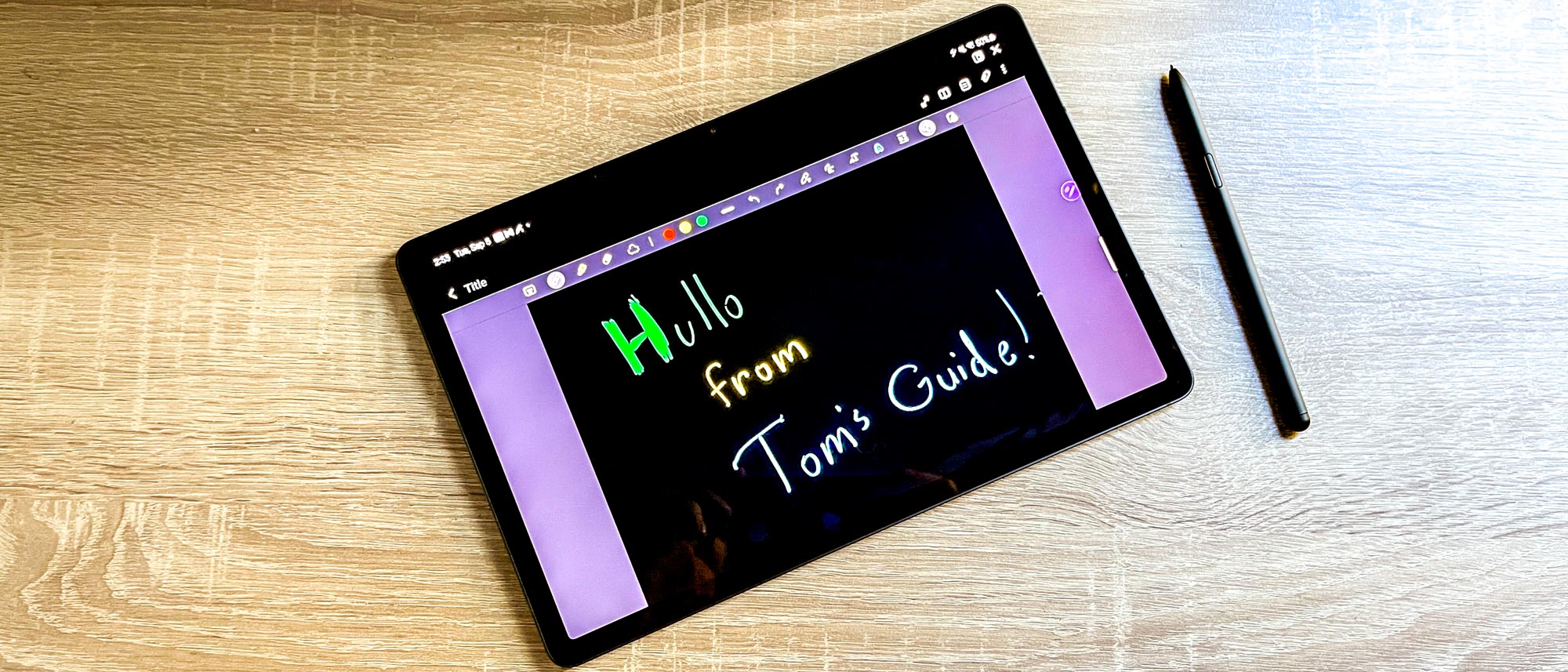Tom's Guide Verdict
The Samsung Galaxy Tab S9 is awfully similar to last year's model, but the AMOLED upgrade sets it apart and makes watching movies and playing games a delight. You pay for it with worse battery life, though, and this Android tablet still can't match Apple's slates in terms of speed.
Pros
- +
AMOLED upgrade is great
- +
Bright, beautiful display
- +
Good speakers
- +
Included S Pen stylus is a great value
Cons
- -
Slower than cheaper, older iPad Air
- -
Middling battery life
Why you can trust Tom's Guide
The Samsung Galaxy Tab S9 ($799 to start) has arrived, and it's the first entry-level Galaxy Tab slate Samsung has shipped with a 120Hz AMOLED display.
That's a significant upgrade from the LED screen that graced last year's Samsung Galaxy Tab S8, and it brings the great AMOLED displays which have been on Samsung's pricier tablets for years down to the entry-level Galaxy Tab S9.
So while the Galaxy Tab S9 has once again shipped alongside its pricier, more premium siblings the Galaxy Tab S9+ and the Galaxy Tab S9 Ultra, for the first time ever you don't have to upgrade to get a great Samsung tablet with an AMOLED screen.
And after a few weeks using a Samsung Galaxy Tab S9 for work and play, I'm pleased to report that the AMOLED upgrade makes a huge difference in day-to-day use. Unfortunately, our testing suggests the tablet's battery life has taken a significant hit as part of this upgrade, and while the Qualcomm Snapdragon 8 Gen 2 chipset powering it is plenty speedy, it still can't outperform Apple's older, cheaper iPad Air (2022).
But if you want a great slate, I think the Samsung Galaxy Tab S9 is one of the best Samsung tablets (and one of the best Android tablets period) on the market right now. Here's why.
Samsung Galaxy Tab S9 review: Specs
| Header Cell - Column 0 | Samsung Galaxy Tab S9 |
|---|---|
| Price | $799 |
| CPU | Qualcomm Snapdragon 8 Gen 2 |
| Display | 11-inch Dynamic AMOLED 2X 120Hz |
| RAM | 8GB |
| Storage | 128GB |
| Ports | USB-C, microSD |
| Connectivity | 5G, LTE , Wi-Fi 6E, Bluetooth 5.3 |
| Accessories | S Pen stylus included |
| Dimensions | 10.01 x 6.53 x 0.23 inches |
| Weight | 1.10 pounds |
Samsung Galaxy Tab S9 review: Price and release date
- $799 to start, less with trade-ins
- Maxed-out model costs $919
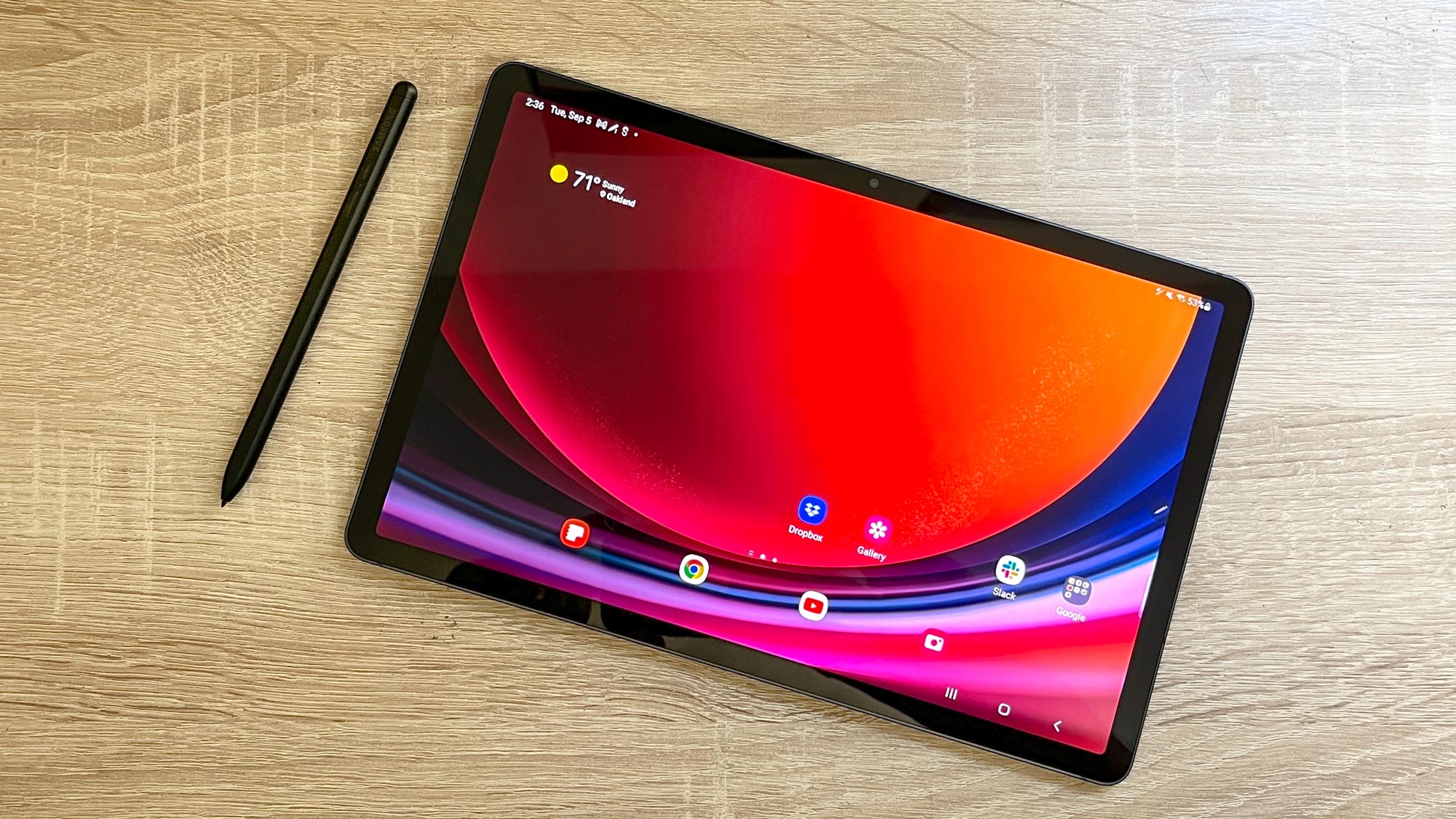
The Samsung Galaxy Tab S9 is available for purchase right now from Samsung's website and select third-party retailers at a starting price of $799. For that you get the tablet with its 11-inch (1,600 x 2,560 pixel) AMOLED 120Hz display, its Qualcomm Snapdragon 8 Gen 2 chipset, 8GB of RAM and 128GB of storage. You also get an S Pen stylus included in the box at no extra charge, which is a great value.
If you want more RAM and space you can upgrade to a Galaxy Tab S9 with 12GB of RAM and 256GB of storage for roughly $120, as a maxed-out Tab S9 is priced at $919.
However, if you buy at the right time you can potentially get a discount thanks to Samsung's aggressive launch pricing promotions, which (at least at the time I'm writing this) are currently discounting the upgraded S9 down to $799—effectively eliminating the cost of upgrading to the more powerful model.
Samsung Galaxy Tab S9 review: Design
- Slim, light and comfortable to hold
- Magnetic charging strip for S Pen remains a nice touch
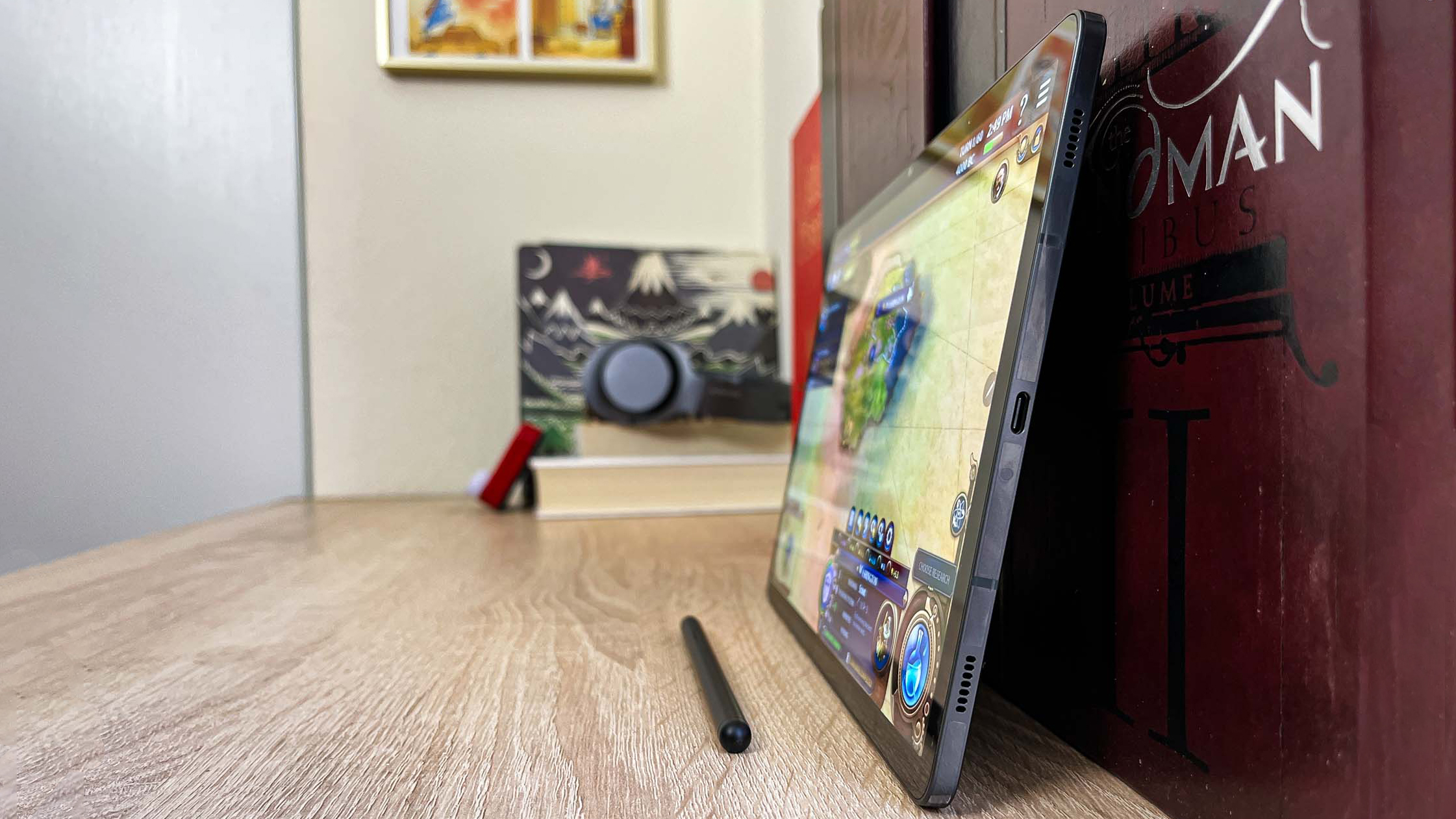
The Samsung Galaxy Tab S9 looks and feels awfully similar to its predecessor, which makes sense since at 10.01 x 6.53 x 0.23 inches large and 1.1 pounds heavy it's basically the same size. It also sports similar ports, with a USB-C jack on one short side and a port on the long edge to the left of it for connecting a Samsung Galaxy Tab S9 Book Cover Keyboard ($199).
If you hold the Samsung Galaxy Tab S9 like a sheet of paper with the USB-C port facing down towards the floor, the power button and volume rocker are conveniently located along the top half of the right edge.
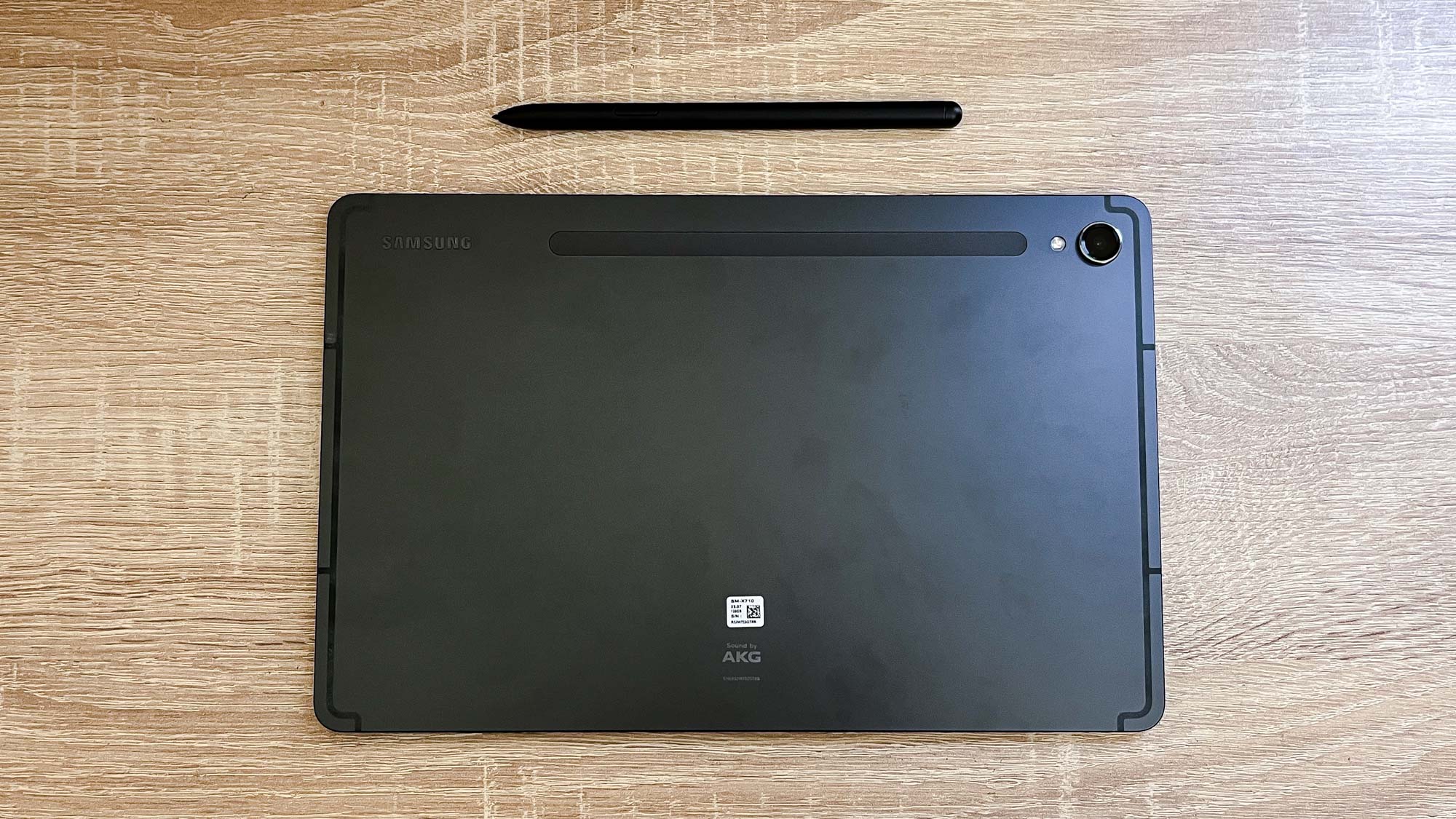
There's a slight bulge on the rear of the tablet where the camera sticks out, and below it on the rear is a vertical magnetic charging strip where you can stick the included stylus when not in use.
Samsung Galaxy Tab S9 review: Display
- 11-inch WQXGA 120Hz AMOLED display looks great, nice and colorful
- AMOLED is a welcome upgrade over last year's LED display
Like its predecessors, the Galaxy Tab S8 sports an 11-inch WQXGA (2,560 x 1,600 pixels) display with a 120Hz refresh rate. Unlike its predecessors, this time it's an AMOLED display.
This is a big deal because it's the first year Samsung has made its base Galaxy Tab slate available with an AMOLED screen, a premier touch heretofore only available on the more expensive Galaxy Tab Plus and Ultra variants. But 2023 is the year Samsung makes AMOLED screens standard across the entire Galaxy Tab S9 lineup, and it's a smart change.
It's likely also the reason why this year's Galaxy Tab S9 starts $100 more expensive than last year's S8, which had a less flashy 11-inch WQXGA LED display.
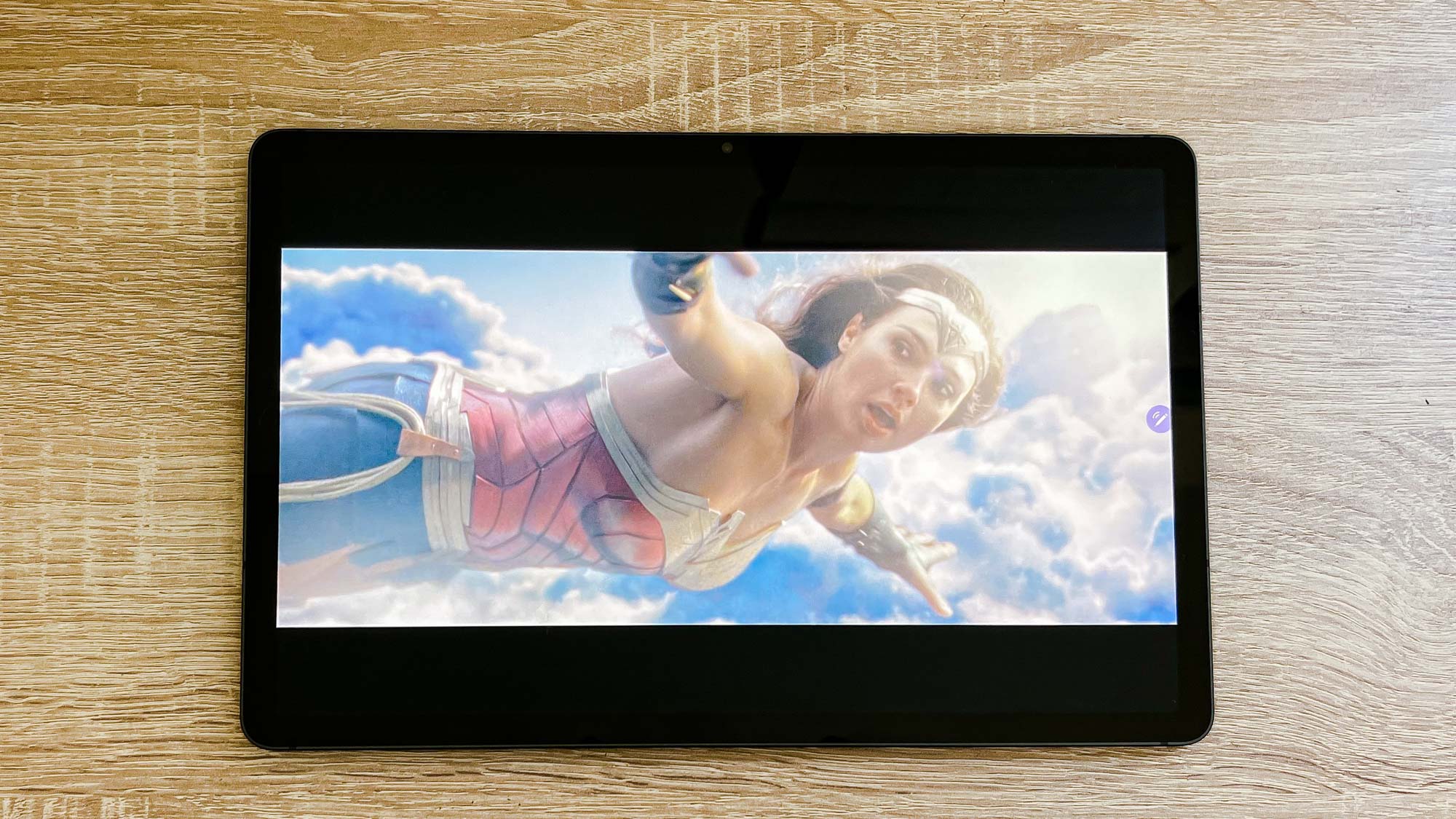
In my time testing and reviewing the Galaxy Tab S9 I had a great time watching videos and playing games on the tablet. While the performance doesn't feel much different from last year's S8, movies like Sorry To Bother You and Wonder Woman 1984 look excellent on the Galaxy Tab S9's AMOLED screen.
| Header Cell - Column 0 | Samsung Galaxy Tab S9 | Lenovo Tab Extreme | iPad Air (2022) |
|---|---|---|---|
| Nits (brightness) | 592 (adaptive), 749 (HDR) | 453 (HDR) | 485 (adaptive) |
| sRGB | 185.2% | 159.4% | 111.8% |
| DCI-P3 | 131.2% | 112.9% | 79.2% |
| Delta-E | 0.26 | 0.34 | 0.29 |
When we aimed our Klein 10-A colorimeter at the Galaxy Tab S9 we found the display to be remarkably bright and colorful. There are two display modes, Vibrant (the default) and Natural. We ran our tests in both and we've displayed the results from Vibrant mode in the chart above since it's the default you'll see when you power on the tablet.
In Vibrant mode the Samsung Galaxy Tab S9 got as bright as 592 nits with adaptive brightness switched on, though that climbed to 749 nits when watching HDR content. The tablet looks a bit oversaturated to my eyes in Vibrant mode, and that's backed up by our finding that it displays 185.2% of the sRGB color gamut and 131.2% of the DCI-P3 color gamut, though those drop down to 111.3$ sRGB/78.8% DCI-P3 in Natural mode.
And as you can see from the results, in Vibrant mode the Tab S9 is brighter and more colorful than Apple's iPad Air 2022 ($699 to start) and the bigger, far more expensive OLED-equipped Lenovo Tab Extreme ($949 to start).
Heck, it's even brighter and more colorful than Apple's top-tier 12.9-inch iPad Pro 2022 (591 nits, 117.1% sRGB/82.4% DCI-P3), though when viewing HDR content our tests reveal the biggest iPad Pro still gets brighter (to the tune of 1,577 nits) than Samsung's entry-level S9.
That's a lot of data and observations to say that the AMOLED display on the Samsung Galaxy Tab S9 is great and a welcome upgrade that helps justify why you'd want to upgrade to this tablet if you already own last year's model.
Samsung Galaxy Tab S9 review: Performance
- Qualcomm Snapdragon 8 Gen 2 makes Android 13 feel plenty snappy
- Still can't outpace the competition, including older, cheaper iPad Airs
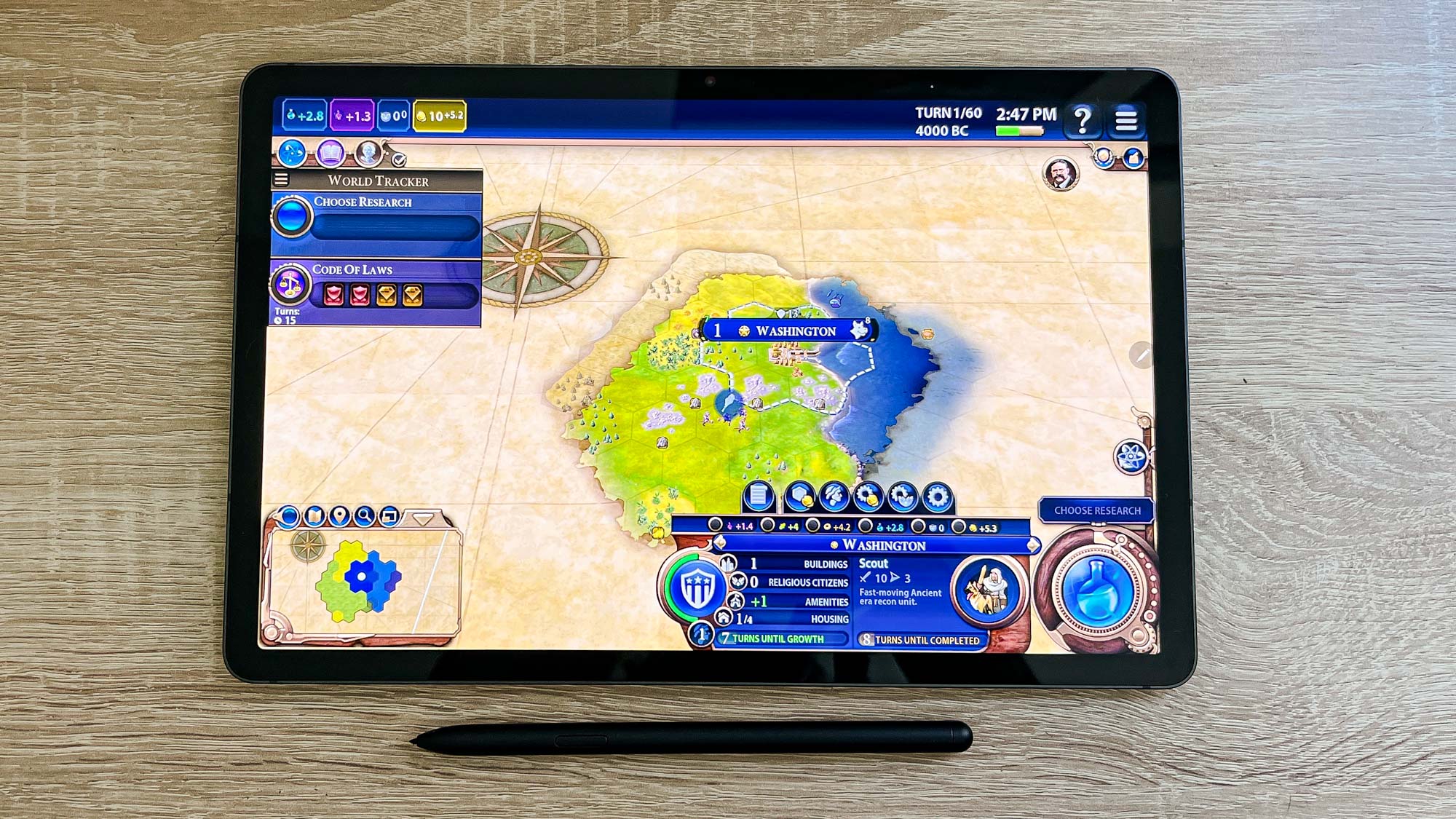
Our Samsung Galaxy Tab S9 review unit is powered by Qualcomm's Snapdragon 8 Gen 2 chipset and 8GB of RAM, which proved more than speedy enough in my hands-on testing.
During the course of my review I had no complaints about the performance of this tablet because everything felt snappy. Flipping between apps, editing media and playing games like Genshin Impact and Sid Meier's Civilization VI felt smooth and straightforward. I certainly had to spend some time waiting for complex games to load, but once I was playing I had no complaints.
Our performance testing backs up my experience, as we found the Snapdragon 8 Gen 2 delivers modest but meaningful performance improvements over the Gen 1 version in last year's Galaxy Tab S8.
But as you can see from the chart below, it still can't compete with the beefier chips in tablets from Apple and Lenovo. Last year's iPad Air is still rocking Apple's old M1 chip, yet as you can see it outperformed this year's Galaxy Tab S9 in raw CPU performance tests.
| Header Cell - Column 0 | Samsung Galaxy Tab S9 | Lenovo Tab Extreme | iPad Air (2022) |
|---|---|---|---|
| Processor | Snapdragon 8 Gen 2 | MediaTek Dimensity 9000 | Apple M1 |
| Geekbench 5 single-core CPU | 1,555 | 1,862 | 1,707 |
| Geekbench 5 multi-core CPU | 5,164 | 8,500 | 7,151 |
| 3DMark Wild Life Unlimited | 14,831 | 25,219 | 17,966 |
The same goes for the MediaTek Dimensity 9000 chipset powering the bigger, more expensive Lenovo Tab Extreme. Of course, it's less surprising that the $1,099 Lenovo OLED tablet outperforms our $799 entry-level Samsung Galaxy Tab S9. What's more embarrassing is the way last year's iPad Air speeds past the Galaxy Tab S9 despite being a year older and up to $200 cheaper.
Still, the discrepancies between these tablets' performance are minor and I don't think you'll be disappointed by the performance of Samsung's Galaxy Tab S9. It remains a great Android tablet for playing games and watching movies.
Samsung Galaxy Tab S9 review: Audio
- Surprisingly loud and full sound quality
- Almost no bass to speak of
You're not going to get much bass to speak of out of the four speakers built into the Samsung Galaxy Tab S9, but you will get a surprisingly loud and full soundscape.
The tablet supports Dolby Atmos (though you need to enable it in the Settings menu under the Sounds and vibration > Sound quality and effects submenu first) while watching media and gaming, and I liked to have it on while watching movies and playing games.
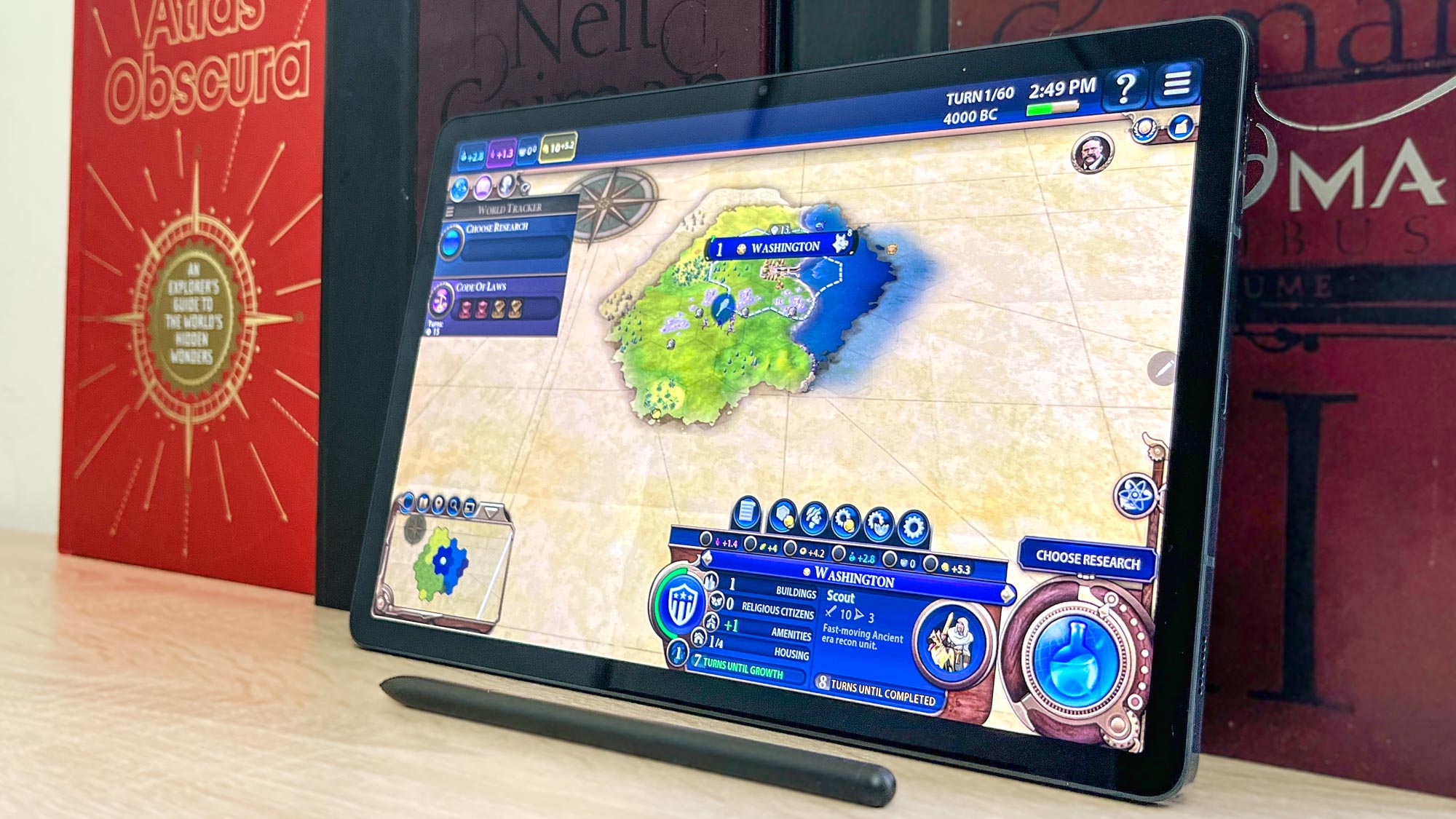
While you won't be DJing any parties with this tablet, I did enjoy listening through a playlist of artists like Kamaiyah, Massive Attack and Open Mike Eagle through its speakers. While bass is basically non-existent, the quality of sound coming out of the S9 is better than I expected and stays consistent even at high volume.
Samsung Galaxy Tab S9 review: Software
- Comes with Android 13, which works well
- Extra Samsung software great if you're into Samsung, otherwise it's bloatware
The Samsung Galaxy Tab S9 arrived running Android 13, and while I'm not the biggest fan of Android I think this version is good and works well on tablets.
However, there's also some Samsung software layered on top of Android, including apps like Samsung Notes, Samsung Cloud and Samsung Flow.
These apps are useful if you already own other Galaxy devices and are enmeshed in Samsung's ecosystem, since they make it easier to share data across your devices. But if this is your only Samsung device, you won't find much use for most of the extra Samsung apps.
Samsung Galaxy Tab S9 review: Accessories
- S Pen stylus works well with Tab S9
- Having it included at no charge is a great value add
Samsung doesn't include any accessories with the Galaxy Tab S9 except an S Pen stylus, but that alone is a great value add that turns this entry-level tablet into a more capable device for taking notes, sketching and creating art.
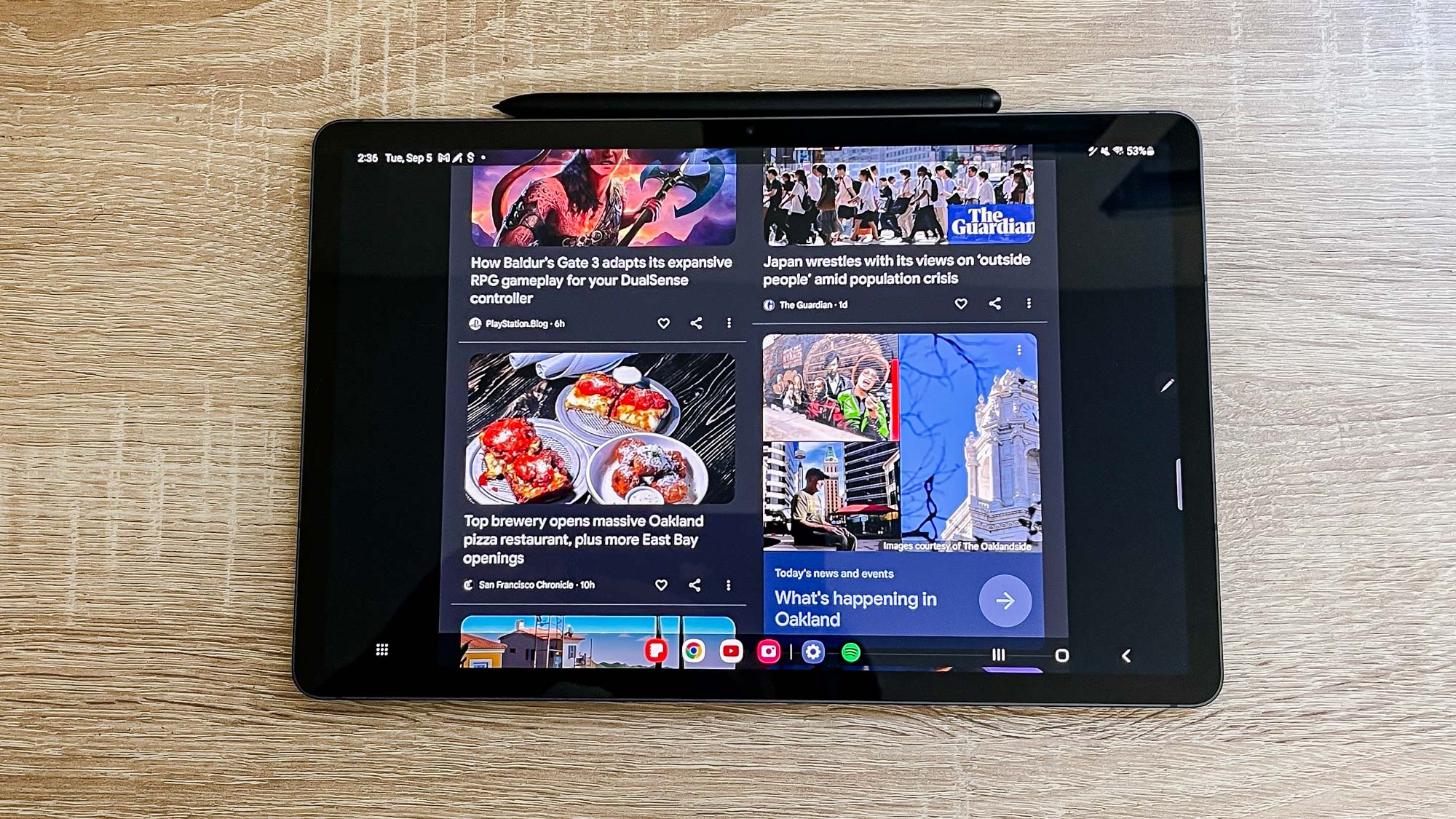
The S Pen works well with the tablet, and I never once had a problem with it not registering or misreading my input. I also like how the S Pen is designed to magnetically attach to the back of the tablet for charging, or to the side for storage when not in use.
Samsung Galaxy Tab S9 review: Cameras
- 12MP UW front/13MP rear cameras work well
- Loss of ultrawide lens on rear camera sucks but isn't a huge deal
The Samsung Galaxy Tab S9 sports a pair of cameras, one on the front with a 12MP ultrawide lens and a 13MP camera on the rear.
This is actually a downgrade from last year's model, since the Galaxy Tab S8 had the same 12MP UW front-facing camera and a 13 MP auto-focus lens plus a 6MP ultrawide lens on the back. This year Samsung removed the ultrawide camera from the back of the entry-level Tab, though it's still present on the more expensive Galaxy Tab S9+ and Galaxy Tab S9 Ultra.
But while it is a downgrade to see Samsung drop the ultrawide lens from the rear of the Galaxy Tab S9, in my day-to-day use I didn't miss it much. That's probably because I don't like the idea of using a tablet to shoot photos, so if I weren't testing this slate for work I'd never have bothered trying to use the rear camera on this tablet instead of whipping out my phone.
The photos and selfies I did shoot looked sharp and colorful, and I have no complaints about the cameras and photo-editing software you get on the Galaxy Tab S9.
Samsung Galaxy Tab S9 review: Battery life and charging
- 9+ hours of battery life is good but not great
- Lasts 3 hours less than predecessor, likely in part due to AMOLED upgrade
Samsung claims the Galaxy Tab S9 can last up to 15 hours on a full charge, and maybe you'll get something close to that if you're really careful. But in our battery test, which tasks the tablet with endlessly surfing the web via Wi-Fi with its screen brightness set to 150 nits, our Tab S9 barely lasted 9 hours before conking out.
| Header Cell - Column 0 | Time (min:secs) |
|---|---|
| Samsung Galaxy Tab S9 | 9:06 |
| Samsung Galaxy Tab S9 Ultra | 9:27 |
| Samsung Galaxy Tab S8 | 12:52 |
| Lenovo Tab Extreme | 9:28 |
| Apple iPad Air (2022) | 1:09 |
| Apple iPad Pro (2022) | 10:37 |
When we switched off adaptive refresh rate and locked the Galaxy Tab S9 at 60Hz to try and conserve battery, it still barely managed 9 hours and 14 minutes in our battery test before running out of juice.
That's okay but not great, and it's over 3 hours less time than its predecessor lasted in the same test. That probably has something to do with the fact that last year's Galaxy Tab had an LED screen, while the Galaxy Tab S9 has a more demanding, power-hungry AMOLED display.
I think the loss in battery life is worth it for the extra color, contrast and brightness you get with the Samsung Galaxy Tab S9's AMOLED screen, but it's important to know that you can't expect the same remarkable battery life we loved about the Galaxy Tab S8.
Samsung Galaxy Tab S9 review: Verdict
I felt the Samsung Galaxy Tab S8 set a new standard for Android tablets in 2022, and now the Samsung Galaxy Tab S9 has upgraded that standard in the best way possible: By upgrading the display.
As much as I wish the Galaxy Tab S9 was more powerful and more power-efficient given that Samsung is asking $100 more for it than last year's model, I can't complain about the company's decision to upgrade the display because the move to AMOLED makes everything you do on the Samsung Galaxy Tab S9 look better than it did on last year's model.
Of course, you are now paying upwards of $800 for the privilege of owning one. If that feels a bit too steep I think you can still get a lot of use out of a new Galaxy Tab S8, which has a worse screen but lasts longer and costs $100 less (or more) new. Apple's 2022 iPad Air is also a great alternative if you don't mind iPadOS, since it costs less than a new Galaxy Tab S9 yet delivers better performance, better cameras and access to Apple's App Store.

Alex Wawro is a lifelong tech and games enthusiast with more than a decade of experience covering both for outlets like Game Developer, Black Hat, and PC World magazine. A lifelong PC builder, he currently serves as a senior editor at Tom's Guide covering all things computing, from laptops and desktops to keyboards and mice.
